It’s no secret that there’s been a dramatic change to the way we shop.
The days of strolling the high streets have been replaced with scrolling eCommerce websites. Whether it be just browsing, doing research, or actually making a purchase, shopping is now synonymous with the internet. So much so that 98% of global consumers shop online.
But with nearly every industry selling their products in the digital marketplace, what’s the best way for your online store to reach customers and drive sales?
The eCommerce takeover has challenged long-standing retail marketing strategies, making way for new approaches to promoting products and winning over customers. In this guide, we’ll cover effective eCommerce marketing strategies for your online business, including tips and best practices for implementing each strategy successfully.
What is Ecommerce Marketing?
Ecommerce marketing is the act of promoting your online store to increase sales.
This includes strategies and tactics focused on building brand awareness, driving traffic and generating leads, and converting visitors into paying customers. These efforts can span across several marketing channels, using both paid and non-paid promotions, and a variety of content types.
Below, we’ll discuss the different types of eCommerce marketing and the strategies that you can use for your own store.
Types of Ecommerce Marketing
Setting an eCommerce marketing strategy depends on several factors, including advertising budgets, target audiences, product types, and promotional materials. And with new marketing channels becoming readily available, such as social media platforms or updates to search engine advertising, strategies are bound to change continuously.
In short, there’s no one perfect eCommerce marketing plan to follow. Instead, it will be a mix-and-match of different types of marketing tactics and strategies.
Here are the most common strategies used by eCommerce marketers.
1. Paid Advertising
Paid advertising is considered an essential part of most eCommerce marketing efforts.
Commonly referred to as pay-per-click (PPC) advertising, this type of marketing uses paid ads to reach audiences and promote products. With PPC campaigns, brands pay an advertising network any time audiences interact with their ad, whether that be an impression or a click.
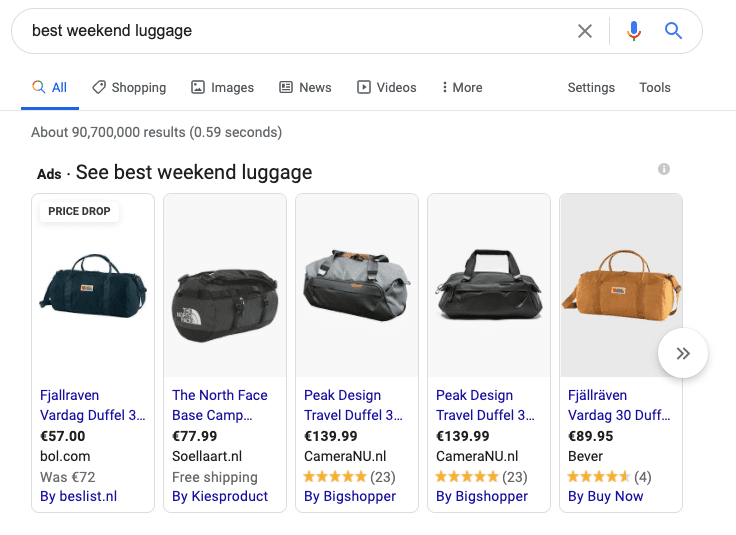
Source: Google
PPC advertising is an effective path to your target audiences, as well as to be seen by potential customers who may not know about your brand yet. For example, a luggage company could pay Google to show their ad anytime someone searches for “Best Weekend Luggage”. This not only puts the product in front of high-quality leads whose intent it is to find luggage, but it also builds brand awareness to those not yet familiar with this particular brand.
Additionally, PPC advertising tends to be quicker and more measurable than other digital marketing tools. It allows brands to get at the top of search results and rank above competitors in a shorter time period, especially in comparison to SEO. It also provides valuable insights into how effective your ads are. Networks like Google and Facebook provide extensive data into where your ads are being seen and by whom. Qualitative data like what images or copy are more effective and the overall ROI of your PPC campaigns is also available.
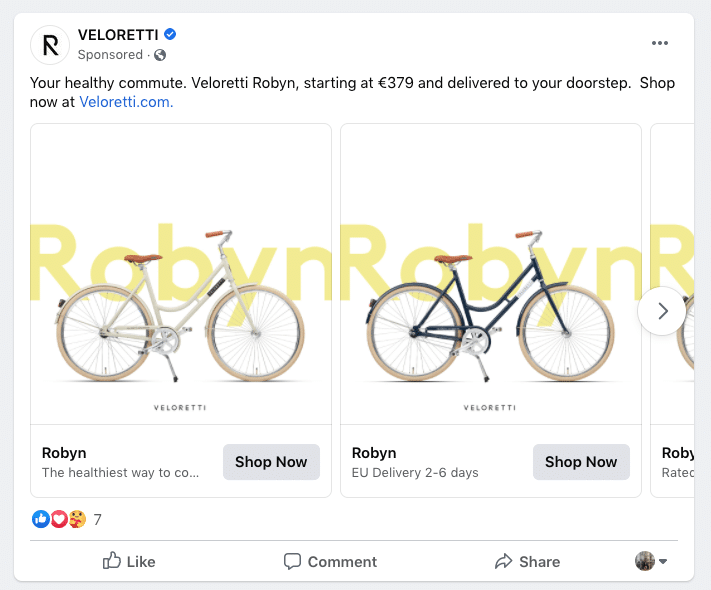
Source: Facebook
There are many different types of PPC campaigns; the most common include:
- Search ads on networks like Google or Bing.
- Social ads on platforms like Facebook, Instagram, Youtube.
- Display and banner ads on external websites.
Notable, but less common, PPC campaigns include Gmail sponsored promotions, YouTube instream ads, and Amazon advertising.
Most useful for eCommerce sites is Google Shopping, which features shopping-specific ads at the top of search engine results. Shown with the ad are an image, pricing details, and short product description so customers intent on online shopping can find what they’re looking for in the search results.
Paid Advertising Best Practices:
-
Find the Best Keywords
Perform keyword research to know which keywords to target for your campaigns. Select key words relevant to your ad and your target audience. Focus on long-tail keywords that will generate more quality leads, and have a lower cost-per-click.
-
Create Relevant Landing Pages
Landing pages are essential for PPC campaigns. When a visitor clicks on your ad, they will want to find the information directly related to their search. If this doesn’t happen, you can almost guarantee that they will immediately bounce — making it so that you lose that website visitor and hurt your Quality Score, which impacts ad placement and bidding costs.
Create different landing pages to match different ads. This includes using headlines that fit with the ad, high-quality images, related content, and a clear, concise call to action (CTA).
-
Evaluate budget and ads regularly.
Getting your PPC campaigns set up is just the start. This type of advertising requires regular monitoring and optimisation. Ensure you are getting the most out of your budget and seeing a strong ROI for your ads — especially since networks like Google and Facebook are highly competitive and tend to have higher costs. You won’t want to waste your budget on high-cost ads that don’t reach your target audience or improve your conversion rate.
2. SEO
Search engine optimization (SEO) is another must-have for eCommerce marketing, whether you’re a large or small business.
In short, SEO is the process of getting your eCommerce site to the top of search results from search engines like Google, Bing, etc. Ranking high on search engines means more visibility for your business, and generating more organic (aka free) traffic to your store.
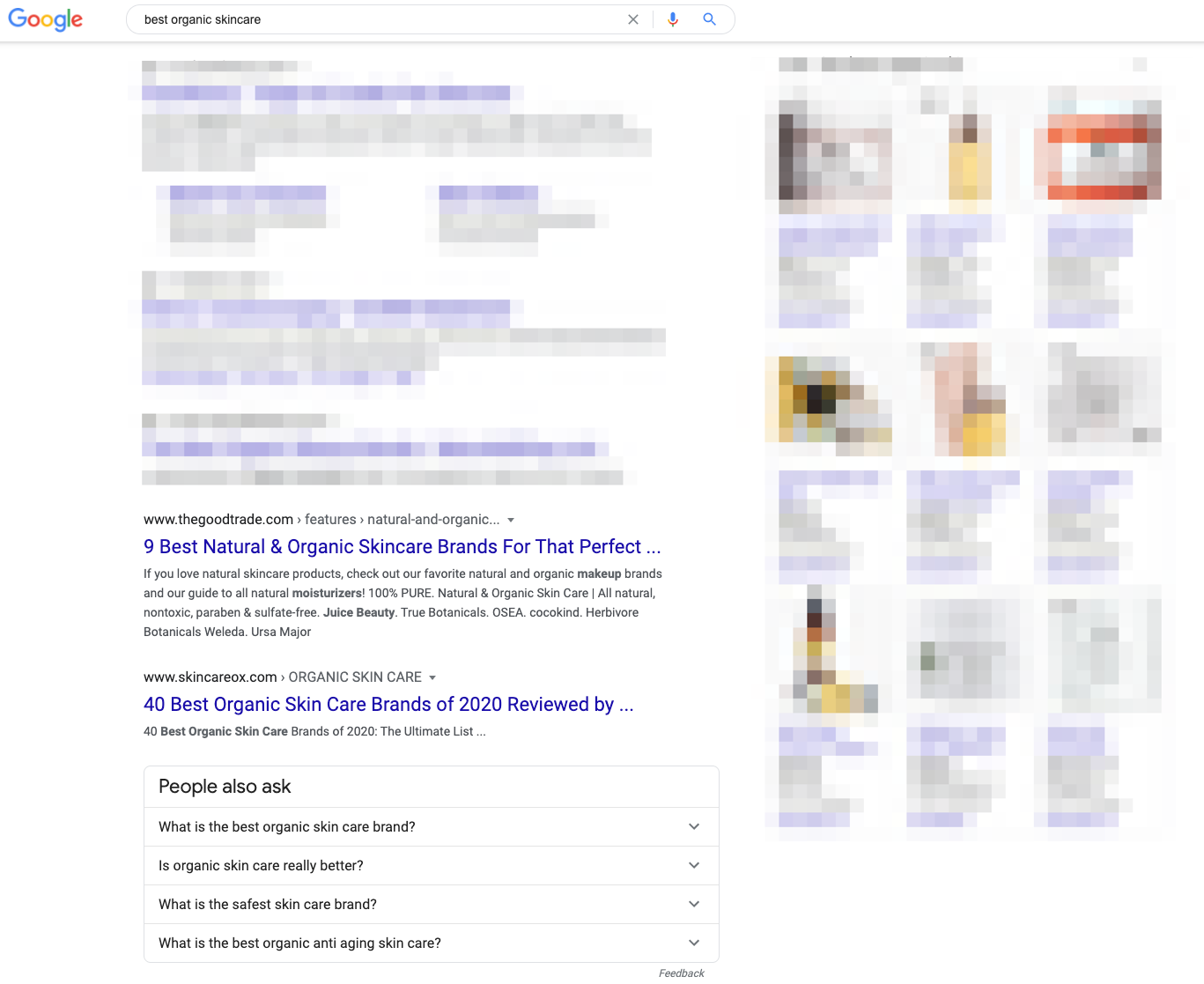
Source: Google
Consider your own personal shopping habits. When you are looking to buy a product, or even just browse, what do you do? Most people’s answer would be a Google search. Appearing at the top of search results puts your store in front of highly-interested audiences, and can reach customers you may not have targeted in paid ad campaigns.
Next to that, organic search results tend to be more relevant to customers than the paid ads displayed at the top of the page. In fact, 70-80% of search engine users are ignoring the paid ads and are only focusing on the organic results.
The overall goal of SEO is to reach customers, get them to click on your link, and then get them to stay on your site. This involves a combination of tactics and optimisations through keywords, site structure, and content.
The starting point for SEO is keyword research to identify the keywords relevant to your potential customer’s searches. This is a process of brainstorming which keywords you think are important, seeing what your competitors are focusing on, and using tools that show metrics like search volume and keyword difficulty.
Along with keyword research, your site’s structure is important. Through proper navigation and internal linking, it should be easy for both search engines and visitors to find what they are searching for. As a golden rule, every page should be able to be reached within three clicks.
From here, you’ll want your site to fit a searcher’s intent. Optimize titles & meta descriptions so that they are easy to read, clear, and to the point when they appear in search engines. Keep in mind that search engines have become increasingly sophisticated. Stuffing your site with irrelevant content just to get clicks doesn’t work, and can actually penalise your site.
SEO Best Practices:
-
Consider the customer experience.
Not only do you want to get customers to click on your site, but you also want them to stay. When a customer clicks on your link, they want answers to their initial search query. If they land on a page with content that’s completely irrelevant or a site so cluttered, they can’t find what they’re looking for. They’ll leave. High bounce rates mean you’re missing out on potential customers, as well as hurting your SERP rankings.
-
Speed matters
Google rewards sites with fast loading pages. Using Google’s PageSpeed Insights tool, you can get insights on where you need to improve.
Page load speed is also important for the customer experience. 47% of consumers expect a web page to load in two seconds or less, and just a one-second delay can decrease conversions.
Be invested in the process.
While you won’t pay for SEO the same way you do PPC campaigns, it’s still an investment. SEO requires time and effort, and it takes much, much longer to see the results. Google algorithms change regularly, so be sure to follow any updates and adjust your site accordingly.
3. Content Marketing
Linked together with your other marketing strategies, content marketing is an effective way to build your online presence and generate leads to your eCommerce site.
Content marketing focuses on creating and using content — like blogs, infographics, video, guides, images, etc. — to reach and engage potential customers. This is a form of inbound marketing, where customers come to you rather than you going out to find customers.
To be clear, this content is not promotional. Instead, it attracts potential customers via search engines or social media by being informative, engaging, and entertaining. For example, someone could be searching for healthy eating and find a blog titled “7 Healthy Meals You Can Cook This Week” written by a food-box delivery service.
Not only does content help bring in potential customers, but it also boosts the effectiveness of your other marketing channels. Quality content can improve SERP rankings and help with overall SEO efforts. It also provides intriguing content for email marketing, newsletters, and social media shares — especially content that people want to share and has the potential to go viral. Informative content like FAQ pages and customer success stories can be used for bottom-of-the-funnel customers who need that final push to make a purchase.
Source: REI
Next to that, content establishes credibility and authority in your industry. For example, American sports gear brand REI writes “Expert Advice” blogs with highly informative content. The blogs are filled with tips and recommendations for the outdoors, such as how to prepare for backpacking or guides to backcountry skiing. From this content, REI is a trusted source for anything related to outdoor sports and the retailer of choice for customers looking for these products.
The most common type of content is blog and article posts. But as the competition grows, a simple 2-3 paragraph blog no longer works. To meaningfully engage customers, content must now be well-researched, filled with videos and images, and extensive in length.
Additional content types for your content marketing strategy include:
- Customer success stories
- Case studies
- Whitepapers and guides
- Interviews
- Infographics
- GIFs
- Quizzes and polls
- Forums and community pages
- FAQ pages
- Downloadable templates
- User-generated content
In the past 10 years or so, video has emerged to be the preferred content type for audiences. This is especially true for eCommerce, as over 50% of global shoppers say online video has helped them decide which specific brand or product to buy.
With new media-centric social media options like YouTube, Instagram, and Tik-Tok, videos can be easily uploaded and shared with content such as tutorials, live Q&A sessions, and influencer vlogs.
Content Marketing Best Practices:
- Create quality content
As we mentioned before, you don’t just need content, and you need quality content. Content that is well written and in-depth is bound to rank higher. While content that is irrelevant or lacking substance will result in high bounce rates, which will consequently hurt your SEO efforts.
And there’s no shortcut to quality content. Google penalises sites for stuffing blogs with keywords or republishing content from sites without permission.
- Start collaborating with other sites.
Collaborating with other sites can prove to be very useful for your content marketing efforts. Through link exchanges and submitting guest blogs, you can put your eCommerce store in front of wider audiences and have a new source for referring traffic to your site.
This also helps with SEO. The more sites that link back to your site signals to Google that your site is credible, and as a result will help strengthen your domain authority.

Source: RunnersNeed
- Provide content for customer success
Beyond the initial inbound marketing, content can play a role in keeping customers and reducing churn. Continuously educate your existing customers about your products with content like video tutorials or virtual workshops. The more content you have that helps customers enjoy and get the most out of your product, the more likely they are to stay a customer.
4. Social Media
With most platforms being free and widely used by target audiences, social media has emerged as a go-to channel for almost every industry, including eCommerce.
Almost every business uses social media in one form or another. When done effectively, social media provides another channel for reaching audiences, including niche-focused audiences that are active in social media groups or forums.
It’s also an opportunity to test new content, like influencer collaborations, or live videos. Having new content to use allows for your brand to interact with customers in unique ways, such as livening customer support with GIFs or running contests that encourage user-generated content.
However, it’s not as simple as setting up a Facebook page.
Social media marketing encompasses a variety of paid and non-paid efforts, ranging from PPC ads that directly target customers to content shared organically by happy customers. This requires planning for which platforms to use, how accounts will be managed and maintained, and what type of content will engage customers.
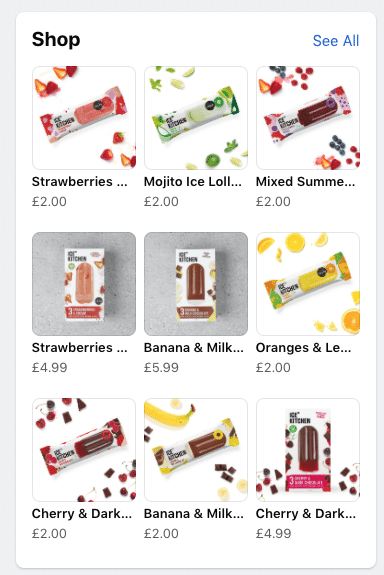
Source: Ice Kitchen Facebook
Certain platforms are now tailored to eCommerce shopping. Referred to as “social commerce”, this streamlines the buying process, making it possible for customers to purchase as they scroll through their timelines. Social commerce features vary by platform but typically include “buy now” buttons, shoppable posts, or 3rd party plugins.
Social Media Best Practices:
- Choose the best platform for your products.
A common mistake for many businesses thinks that they need to have some sort of presence on every social media platform. Although most platforms are free, there is a considerable amount of work that’s required. Failing to give the proper attention required could actually hurt your credibility — for instance, if someone goes to your page and it hasn’t been updated in years.
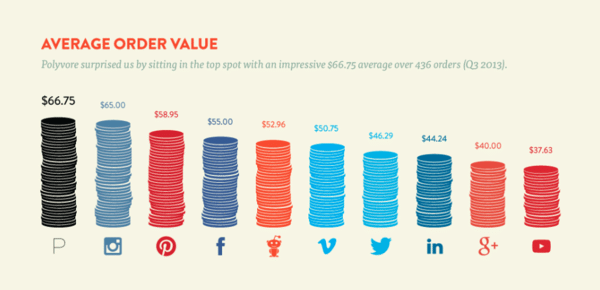
Source: Shopify
Ecommerce is highly visual. Images and video are needed to show off the product to audiences, and successful social media campaigns follow this logic. For example, visually-centric platforms like Instagram or Pinterest are more fitting for eCommerce brands than other social media like Twitter.
- Leverage user-generated content
User-generated content (UGC) is content — like posts, tweets, images, videos, blogs, reviews — that comes organically by your customers.
Typically created and shared on social media, UGC is a major asset to your social media presence, with 86% of Millennials saying that UGC is a positive indicator of a brand’s quality.
Here are some ways to encourage UGC:
- Share and repost any content from customers.
- Promote brand-specific hashtags throughout all channels.
- Host social media contests and giveaways.
- Spotlight social media posts from customers on your website/product pages.
- Create viral challenges around your brand’s product.

Source: Instagram
For example, Australian brand Frank Body was able to grow their brand using only social media and UGC. The brand’s hashtags #letsbefrank and #thefrankeffect were promoted across social media accounts, website pages, and products themselves. From this UGC-focused marketing campaign, the company was able to reach a worldwide audience with over 100,000 images uploaded by customers. This successful marketing strategy brought the retailer over 20 million in earnings.
- Try Influencer Marketing
Influencers and social media go hand-in-hand. Influencers are primarily on social media platforms like Instagram, YouTube, and TikTok, and have the ability to reach niche audiences and introduce your products to their dedicated followers.
Since it is growing as an industry, there’s plenty of agencies and databases to find influencers to partner with. But you can also do your own search by following hashtags and trends to find users posting content related to your brand. For example, if you are a makeup retailer, you can search #mua or #beautyblog to find influencers that would fit with your products and target audience.
It’s important to not limit your search to only influencers with very high follower counts. Micro-influencers — influencers with 1,000 to 100,000 followers — can be just as effective. In fact, Impact found an increase in followers results in a decrease in engagement; and influencers with 1,000 followers had an engagement as high as 85%.
5. Affiliate Marketing
Incentivize word-of-mouth promotions with affiliate marketing. Affiliate marketing encourages individuals to promote your brand in exchange for a commission, typically when their referrals make a purchase.
Using affiliate tracking software, anyone from your existing customers to influencers can promote your brand using referral links to send traffic to your site. Referral links can be shared on social media, on websites and blogs, or even with customers personally referring friends and family.
With 92% of people trusting recommendations from friends and family, this can be a high-converting channel for eCommerce businesses. And the pay-for-performance model means you only pay for ads that actually result in purchases. This makes affiliate marketing very cost-effective, especially in comparison to the rising costs of Google and Facebook ads.
As a result, affiliate marketing has become increasingly popular in recent years, and eCommerce retailers of all sizes are turning to affiliate marketing, including Amazon.
Amazon runs one of the largest affiliate marketing programs in the world, Amazon Associates. The program partners with publishers and creators to promote Amazon products, offering up to 10% commission and allows affiliates to monetise their content.
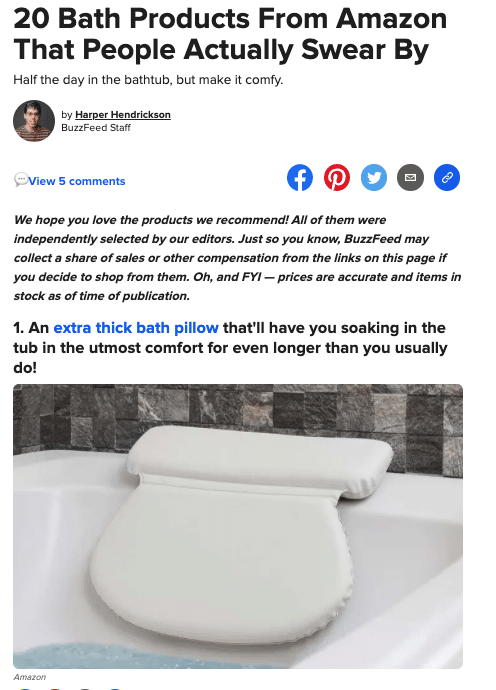
Source: Buzzfeed
One of Amazon’s most prominent affiliates is digital media outlet Buzzfeed. Buzzfeed often promotes the retail giant with content like “Here’s What’s Actually Worth Buying on Prime Day” or “60 things on Amazon with 5 Star Reviews”. The listicle-style content includes a short disclaimer saying they collect a share of the sale and provides links to the featured products. From these promotions, Buzzfeed drove more than $425M indirectly attributable transactions last year.
Affiliate Marketing Best Practices:
- Find a variety of affiliates.
Affiliates can be anyone from your loyal customers to top-name influencers.
Some companies make their affiliate program available for anyone to join, allowing for more people to promote their products and the opportunity to reach untapped markets. Other companies choose to make their affiliate program invite-only, have more control over who is promoting their products, and where they are promoting.
There are several different types of affiliates you can utilise to promote your eCommerce business, including:
- Existing customers
- Influencers and micro-influencers
- Niche bloggers
- Review websites
- Industry experts and forum groups
- Non-competitive businesses (i.e. coffee brand and espresso machine makers)
- Set a competitive commission rate.
For eCommerce, affiliates will typically earn a 1-time commission when their referral makes a purchase. Commission amounts can be a flat rate or a % of the sale.
To stay competitive, you can offer commission tiers and bonus schemes. This is a great way to attract top promoters and further incentivise top-performing affiliates. Bonuses can be given regularly, whenever an affiliate hits a certain sales target, or during certain periods where you really want to boost conversions.
For example, an airline company could use bonus commissions in the winter off-season when bookings are lower. The bonus commission will encourage affiliates to be more active in promoting, which will help the airline gain high-quality referrals in a time with slower traffic and conversions.
6. Email Marketing
Email has always played an important role in eCommerce marketing and still does today.
Email marketing allows you to connect with customers and subscribers directly. Since this is something that audiences can’t scroll right past, you’re more likely to grab their attention and with the right content, increase engagement.
This is especially true if emails are personalised, with 74% of marketers saying targeted personalisation increases customer engagement. Content can be strategically tailored to fit individual customers. Whether that be with their name, celebrating specific milestones, products they’re interested in or offers that reflect where they are in the buying process, such as cart abandonment.
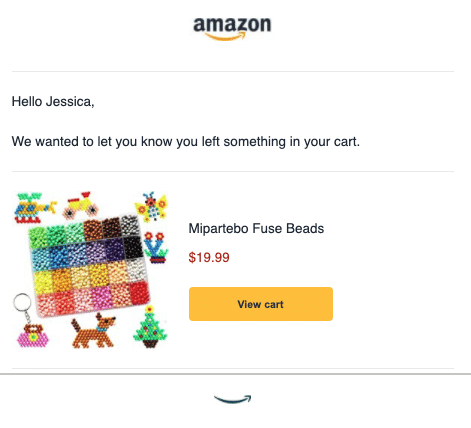
Using automation tools, setting up highly personalised email campaigns is no longer a painstaking task. Drip campaigns can be set up to send emails based on customer segments and sent automatically based on select triggers.
Email Marketing Best Practices:
- Segment Email Lists
For emails to be most effective, it’s necessary to segment your email lists accordingly. These segments can be based on buyer personas, product interests, or where they are at in the buyer’s journey.
Emails for visitors who are completely new to your site will look different from emails for returning customers who already have products in their shopping cart. They should be tailored to a recipient’s place in the customer journey. For example:
- Awareness stage: Emails should focus on introducing your brand to the customers. Consider using educational content about how to use your products or what makes your brand unique. This is also a good time to offer a welcome discount to bring these customers back to your store.
- Consideration stage: This stage is about building trust and showing why this customer should buy from your brand. This is a great time to incorporate social proof, like reviews and testimonials, or more in-depth content like customer success stories.
- Decision stage: These emails should be centred around closing the deal. Offer incentives that prompt the customer to buy. This could be sending personalised emails with products they saved or sending a free shipping code for customers with abandoned carts.
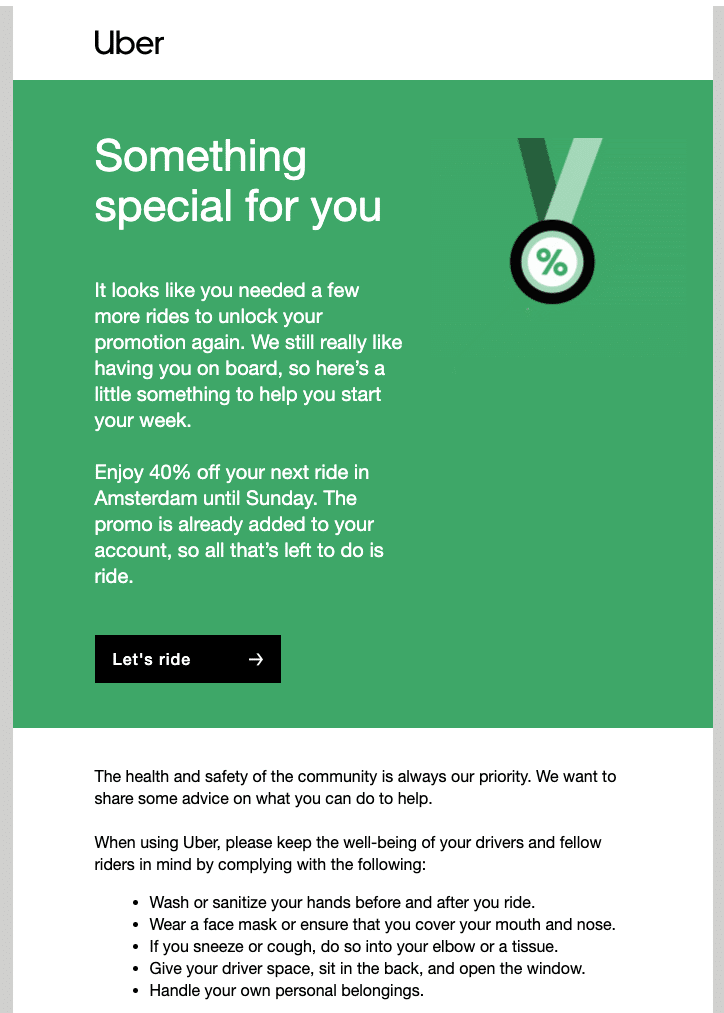
Source: Uber
- Send different emails
While the end goal is, of course, to get customers to your site to make a purchase, emails should not solely focus on the sale. Instead, use email campaigns to engage customers regularly throughout the year and build brand loyalty.
These emails can include:
- Welcome email
- Informational guides
- Milestone email (i.e. birthday, anniversary)
- New product announcements
- Survey and feedback
- Customer appreciation (i.e. early sale access, discount code)
- Newsletter
- Unique holidays (i.e. National Coffee Day)
Consider using different landing pages for each of the different email types. For example, a cart abandonment email could lead customers to a product page of the item they’re interested in. Or a holiday email could feature a product page with curated holiday wish list items.
Tips for Ecommerce Marketing
Along with the strategies and channels discussed above, here are a few more tips you can use throughout your entire eCommerce marketing plan.
Focus on personalisation
Personalised marketing not only helps you reach your target audience better, but it also provides a better overall customer experience. So much so, that 80% of consumers say they are more likely to do business with a company if it offers personalized experiences.
The following elements are key for personalisation:
- Collect plenty of data.
- Segment your customers.
- Create different content for different segments.
Include social proof
Social proof is how the actions of other people influence our decision making — if everyone thinks it’s great, then it must be great.
For example, if you see a line outside a restaurant, you’ll probably believe that a restaurant is pretty good and you’ll want to try it. Or if you are looking for a new hairstylist, you’ll ask friends for their recommendations and read reviews online to help during the decision making process.
When used in digital marketing, social proof can be a powerful tool for building brand awareness, increasing credibility, and most importantly, driving conversions.

Source: Slip
Social proof can be incorporated into your website design, marketing material, advertisements and display banners, social media posts, and email campaigns. Below are the most common types of social proof:
- Customer Reviews
- Testimonials
- Expert and celebrity endorsements
- Trust seals
- Media mentions (i.e., As seen on BBC)
- Awards and Recognitions
- Brand stats (i.e., Over 1000 Customers Served)
Optimise for all devices
Over half of the U.K.’s eCommerce shopping is conducted on a mobile device.
With more and more consumers using mobile to shop, your marketing must be optimised for all devices. Some elements to consider include:
- Reworking the buying process: Create the shortest path to checkout. 77% of smartphone shoppers are more likely to purchase from companies whose mobile sites or apps allow them to make purchases quickly.
- Design a responsive website design: Images and content should fit nicely regardless of screen size. Rewrite headlines to be shorter and more direct for mobile customers, as they shouldn’t have to scroll too much before seeing a CTA.
- Keep speed: Mobile and tablets should be just as fast as desktop. This is very important, as mobile sites that load in two seconds or less have a 15% higher conversion rate than the average mobile site.
Conclusion
There’s a lot of factors that will ultimately impact your eCommerce marketing plan. Who your customers are, what products you offer, and where you want to take your business will direct which strategies you’ll use and how successful they will be.
Keep in mind that marketing strategies are constantly changing and evolving with new eCommerce platforms and features. The best advice is to constantly test, test, and test some more, to see what works best for your store.
Originally published Dec 16, 2020, updated Jan 16, 2023




